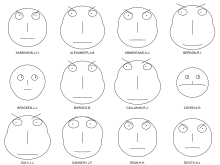Chernoff faces
Chernoff faces are a technique developed by Herman Chernoff to visualize multivariate data using human faces.
The basic idea of data visualization through faces is that it is easy for a person to recognize even small differences in human faces and thus the complexity of multivariate data (e.g. properties of types of beer, variables of apartment apartments, etc.) via this Chernoff system - "Faces" easier to grasp.
Each variable of a data set is assigned one of eighteen facial features, e.g. B. Position, position or size of the face, eyes, eyebrows, mouth and nose, so that an individual face is created for each observation.
Construction of a Chernoff face
This picture shows an example of how a construction of a Chernoff face is carried out. All lengths marked with letters are determined by the values of an observation. Here, these values must be subjected to a previous normalization.
asymmetry
In 1981, Bernhard Flury and Hans Riedwyl proposed asymmetrical Chernoff faces. Since a Chernoff face is vertically symmetrical, i.e. the left and right halves of the face are identical, one side of the face can in principle be dispensed with. Tufte also criticized this redundancy in the presentation . By using asymmetrical faces, the number of variables that can be represented can be doubled.
See also
Individual evidence
- ^ Herman Chernoff : The Use of Faces to Represent Points in K-Dimensional Space Graphically . In: Journal of the American Statistical Association . tape 68 , no. 342 , June 1973, p. 361-368 , doi : 10.1080 / 01621459.1973.10482434 , JSTOR : 2284077 .
- ^ Bernhard Flury, Hans Riedwyl: Graphical Representation of Multivariate Data by Means of Asymmetrical Faces . In: Journal of the American Statistical Association . tape 76 , no. 376 , December 1981, p. 757-765 , doi : 10.1080 / 01621459.1981.10477718 , JSTOR : 2287565 .
- ↑ "Halves may be easier to sort (by matching the right half of an unsorted face to the left half of a sorted face) than full faces. Or else an asymmetrical full face can be used to report additional variables (Flury & Riedwyl 1981) . Bilateral symmetry doubles the space consumed by the design in a graph, without adding new information. " pg 97, The Visual Display of Quantitative Information

